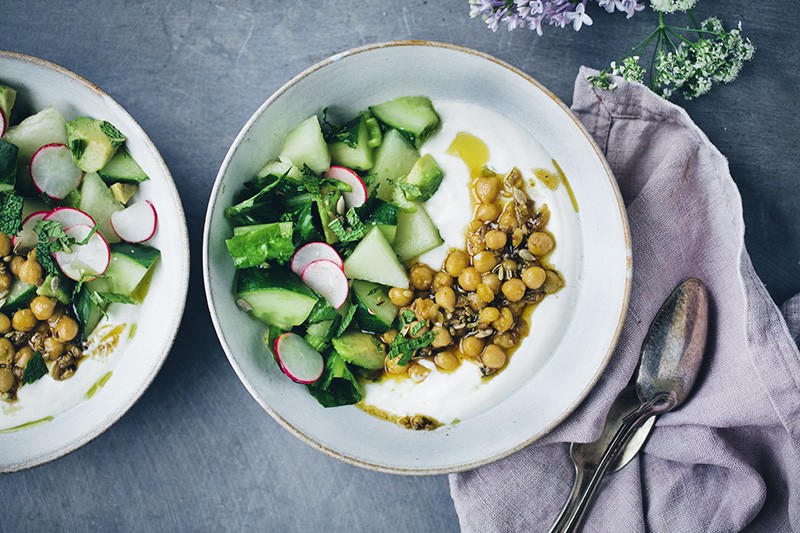We know that it has been terribly quiet around here during the last couple of weeks. Sorry for that. After we had sent the book manuscript to our editor (big sigh of relief there!), all of us needed a short break to catch up on life again. But now we are back. And our plan is to slam you with a whole set of new recipes during this coming autumn. We have for example been making several different delicious desserts with blueberries, but we’ll save that for a later post.
Today we have prepared something that we make more and more frequently in our home. We live only a few blocks from a great Korean restaurant. And after our third take-away from them in ten days, we decided that it was time to learn how to make some Korean food ourselves. Our favorite dish is Bibimbap, so that is what we started with. Bibimbap is not only fun to say, it is also fantastic to eat, as it combines all kind of sweet, strong and sour flavors.
We don’t know how familiar you are with Korean food, so here is a short explanation. A bibimbap is basically a rice dish topped with a variety of vegetables (pickled, stir-fried, cooked or marinated), the Korean chili sauce gochujang and a sunny side fried egg. So far so good, right? Now here comes the wild part. When you have assembled a perfectly balanced and beautiful bowl of vegetables, it is time to take your chopsticks and stir everything into a mess. Not as beautiful anymore, but twice as creamy and delicious. In our version we have added ginger marinated tofu, fresh mango, and use black rise instead of ordinary white. But apart from that it is pretty straight forward.

This dish is great to do when you have a dinner with friends. Both the pickled vegetables and the marinated tofu can be prepared in advance and stored in jars. And when it’s time for dinner, you just cook the rice, fry a few eggs, put vegetables in bowls on the dinner table, and let everyone arrange their own plate.
We sometimes make our own kimchi using David Leibowitz recipe, but you can find ready-made in all Asian supermarkets. There, you will also find Gochujang sauce (apparently it can also be replaced with Sriracha sauce). Don’t take our choice of vegetables too serious, this recipe is great to do when cleaning out the fridge. Almost any vegetable can be used. But don’t skip out on the kimchi or Gochujang sauce, it is what makes the rest of the vegetables sing and sparkke at the edge of your mouth.
Vegetarian Bibimbap
Serves 4
ginger marinated tofu, recipe below
quick pickled cucumber, recipe below
2 cups (500 ml) black rice
2 carrots, cut into thin sticks
½ daikon radish, cut into thin sticks
1 ripe mango, thinly sliced
2 nori sheets, cut into thin strips
200 g oyster or shitake mushroom, sliced
200 g fresh spinach
4 eggs, fried sunny-side-up
1 large handful mung bean sprouts
1/2 cup kimchi, store-bought or homemade (spicy fermented cabbage)
1 tbsp sesame seeds, black or white
¼ cup (1/2 dl) gochujang (Korean chili & soy bean sauce)
Ginger Marinated Tofu
200 g firm tofu
1-2 tbsp sesame oil
2-inch (5 cm) fresh ginger, grated
2 limes, juice
Drain the tofu and pat dry with a kitchen towel. Cut into thin 2-inch (5 cm) wide triangles and place on a large plate. Drizzle with sesame oil, grated ginger and lime juice. Toss so everything is coated. Place in the fridge for at least 30 minutes, turn occasionally.
Quick-Pickled Cucumber
½ large cucumber
6 tbsp apple cider vinegar
4 tbsp water
1 tbsp runny honey
½ -inch fresh chilli, minced
a pinch of salt
Divide the cucumber and remove the seeds lengthwise with a small spoon, then slice thinly. Stir the rest of the ingredients together in a mixing bowl, add the cucumber slices and toss so all slices are coated. Place in the fridge for at least 30 minutes, toss occasionally. Drain and serve.
How to cook black rice
Place the black rice in a sieve and rinse well, then place in a medium saucepan with 4 cups (1 liter) water and ½ tsp salt, bring to a boil, cover and lower the heat to simmer. Let simmer on low heat for 30 minutes. The rice should feel soft, yet chewy. If it is too tough, place the lid back on, remove from the heat and let rest for 10 more minutes.
Preparing Bibimbap Ingredients: Start by making the marinated tofu, the quick-pickled cucumber and then cook the rice. Cut the carrots and daikon into very thin sticks, then slice the mango and cut the nori into thin strips. Set aside in separate bowls. Add olive oil to a large frying pan on medium heat, add the spinach and let cook for a few minutes, stirring occasionally. When done, transfer to a bowl and set aside. Wipe the frying pan clean, add a dash of olive oil then fry the mushrooms on medium heat for 7-8 minutes, stirring occasionally. When done, transfer to a bowl and set aside. Wipe the pan clean again, then fry the eggs on one side on low heat, you want to keep the yolk loose.
Assembling Bibimbap: You can either make 1 very large bowl or 4 smaller bowls. Place the rice in a bowl, then place tofu, carrots, daikon, mango, nori, cucumber, mushroom, kimchi, spinach, sprouts in small portions around the rice, sprinkle with sesame seeds and top with an egg and a dollop of Gochujang sauce. Stir around, using your chopsticks, before eating.
Enjoy!









45 Comments